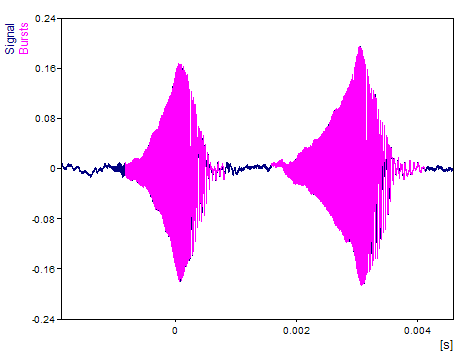Bursts (FPScript)
Searches for beginnings and/or ends of bursts in a data set.
Syntax
Bursts(DataSet, Threshold, DeltaX, [ Orientation = EVENT_BOTH ] [ , Operation = EVENT_DEFAULT ])
The syntax of the Bursts function consists of the following parts:
Part |
Description |
||||||||||||
|---|---|---|---|---|---|---|---|---|---|---|---|---|---|
DataSet |
The data set to be searched. Permitted data structures are data series, data matrix, signal und signal series. All numeric data types are permitted. For complex data types the absolute value is formed. If the argument is a list, then the function is executed for each element of the list and the result is also a list. |
||||||||||||
Threshold |
Specifies the threshold value for the burst search. Those values are assigned to a burst, for which at least one of the neighboring values in the interval [-DeltaX, DeltaX] to the left or right lies above the threshold value. Permitted data structures are scalar value. All numeric data types are permitted. The unit has to be compatible with that of parameter DataSet. For complex data types the absolute value is formed. If the argument is a list, then the function is executed for each element of the list and the result is also a list. |
||||||||||||
DeltaX |
Determines the interval [-DeltaX, DeltaX], within which at least one value has to lie above the threshold value in order to assign the value to be examined to the burst. Permitted data structures are scalar value. All numeric data types are permitted. The unit has to be compatible with that of parameter DataSet. For complex data types the absolute value is formed. If the argument is a list, then the function is executed for each element of the list and the result is also a list. |
||||||||||||
Orientation |
Specifies whether burst beginnings, ends or both are to be searched for. The argument Orientation can have the following values:
If the argument is a list, then the first element in the list is taken. If this is also a list, then the process is repeated. If this argument is omitted, it will be set to the default value EVENT_BOTH. |
||||||||||||
Operation |
Specifies the way the function operates. The argument Operation can have the following values:
If the argument is a list, then the first element in the list is taken. If this is also a list, then the process is repeated. If this argument is omitted, it will be set to the default value EVENT_DEFAULT. |
Remarks
The DeltaX argument should be as low as possible, but higher than the duration of the period, so that individual waves are not taken to be individual bursts. Not only periodic signals can be analyzed with this function. For example, you can use the function to extract a ramp from a signal. For DeltaX equal to zero, the function represents a simple threshold value discriminator.
The following illustration shows a signal with two highlighted bursts:

Available in
FlexPro Basic, Professional, Developer Suite
Examples
Bursts({0, 0.1, 0, 0.1, 1.3, 1.2, 1.4, 0.3, 0.1, 0, 0.2}, 0.2, 1) |
Results in {3L, 8L}. This example searches for burst beginnings and ends and returns the indices. A value belongs to a burst if it or the left or right neighboring value is over 0.2. |
See Also
You might be interested in these articles
You are currently viewing a placeholder content from Facebook. To access the actual content, click the button below. Please note that doing so will share data with third-party providers.
More InformationYou need to load content from reCAPTCHA to submit the form. Please note that doing so will share data with third-party providers.
More InformationYou are currently viewing a placeholder content from Instagram. To access the actual content, click the button below. Please note that doing so will share data with third-party providers.
More InformationYou are currently viewing a placeholder content from X. To access the actual content, click the button below. Please note that doing so will share data with third-party providers.
More Information